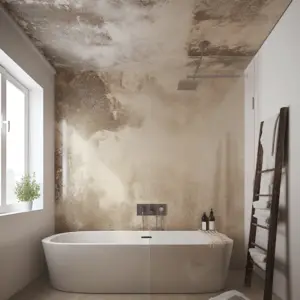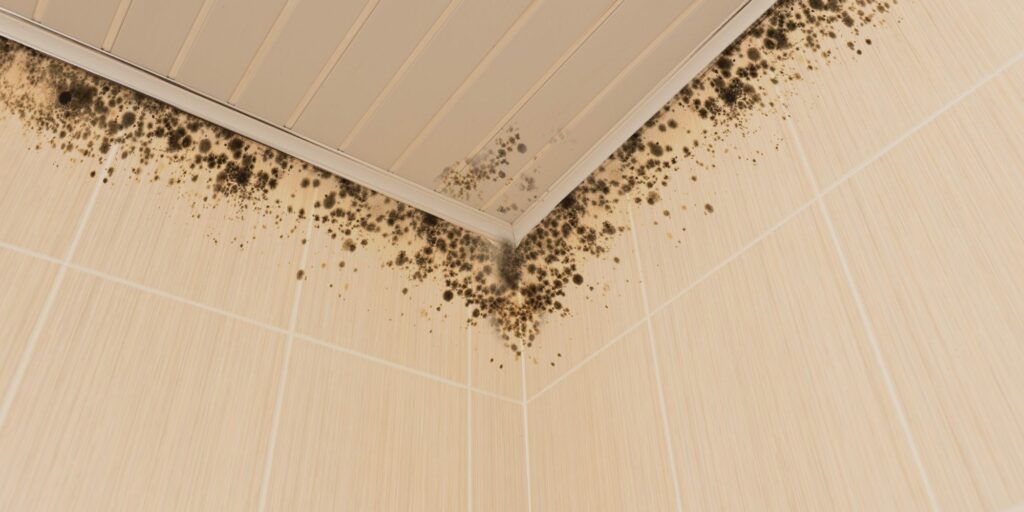Prevent Bathroom Ceiling Mold, A bathroom ceiling is a great place for mold to grow. The moisture from the shower, bathtub and sink can create a perfect environment for mold to thrive. If you have been noticing black or green spots on your bathroom ceiling, you may have mold growing in your home.
Mold spores are microscopic and float through the air, so they can become trapped in the crevices of your bathroom ceiling. Once they land on the surface, they begin to grow and spread.
Mold needs two things to grow:
Moisture: To make mold spores germinate, they need water or moisture to grow. This can be from condensation, leaks, or even humidity.
Organic matter: Mold needs food (organic matter) to grow on. Organic materials include wood, paper, and fabric—things you might find in your bathroom ceiling!
Mold growth can be prevented by keeping your bathroom extremely dry and free of moisture. To prevent mold from growing in your bathroom ceiling, wipe up any excess water after showering or bathing, use a fan to circulate air, and open the windows when it’s humid outside.
Mold can cause health problems and cause damage to your home. You need to take the right steps to prevent mold from growing on your bathroom ceiling.
Table of Contents
How to Prevent Mold in Bathroom Ceiling

Bathrooms are the most susceptible room in the house to mold growth. That’s because moisture is present in bathrooms almost all the time. Even if you don’t have a leaky faucet or damaged pipes, humidity can still be your enemy.
Here are some tips and tricks on how to prevent mold in bathroom ceilings:
Try Antimicrobial Paint
Antimicrobial paint will kill mold and other microbes on contact. You can find this kind of paint at most home improvement stores or online. A light coat will protect your ceiling for years at a time, with minimal upkeep needed afterward. Painting over existing paint is an easy way to prevent mold from growing underneath the surface.
Choose a paint that has been rated by the Consumer Product Safety Commission as “mold resistant,” and make sure it’s applied in a well-ventilated area. If you’re painting your bathroom ceiling, ensure there isn’t anything blocking ventilation holes or cracks around light fixtures or recessed lights – these areas need plenty of airflow around them to prevent condensation from forming on the surface.
Use Borax
Borax is a natural ingredient that is known to kill bacteria, molds, and fungi. Mix borax with water until it’s thick like peanut butter and apply it to your bathroom ceiling with a paintbrush or roller (you’ll need a respirator mask and goggles).
Allow it to dry completely before applying another layer if necessary because borax doesn’t bond well with damp surfaces (which is why we recommend drying the area first).
Use Bleach Solution
Bleach can be used to clean surfaces where mold has formed or where it might appear in the future. It’s important to note that bleach isn’t effective against all types of molds – some will continue growing even after being treated with bleach.
For long-term results, bleach is not ideal.
Bleach will kill mold spores, but it does not prevent them from coming back. Also, bleach can damage some surfaces, so be careful when using it around your home. To use bleach effectively against mold on your bathroom ceiling, use an all-purpose spray cleaner with bleach in it to get rid of all of the mold stains at once.
Get a Dehumidifier
Prevent Bathroom Ceiling Mold bathroom gets too humid, it’s an ideal breeding ground for mold and mildew. You can reduce the humidity level by installing a dehumidifier or by running a fan while showering or bathing.
A dehumidifier works by removing moisture from the air using a fan that blows air over cold coils. The coils condense water from the air into a tank so it can be drained outside or recycled back into your home’s water system.
You might want to consider getting an exhaust fan if you have an older home that doesn’t have one already; these fans draw out moisture from the air before it can condense on your ceiling.
Try Vinegar
Vinegar is another good solution for killing mold spores on hard surfaces without harming your health or the environment like bleach does. Vinegar kills over 80% of all types of mold and leaves no harmful residue behind once it dries up after application.
Mix equal parts of water and vinegar together in a spray bottle and spray onto affected areas of your bathroom ceiling once every month or so for long-term results without having to scrub away at the mold yourself each time!
Clean Your Bathroom Ceiling Regularly

Regularly cleaning your ceiling with bleach or vinegar kills mold spores and prevents their reappearance.
Mold loves dirty surfaces, so keep your ceiling clean to avoid it. Clean using safety goggles since bleach and vinegar aren’t poisonous when used properly but might hurt your eyes if they get into them.
Conclusion
There are simple ways to avoid mold in your bathroom ceiling. The first step is to air your bathroom and remove moisture fast. Install a dehumidifier or use a fan to reduce humidity in your home.
If the ceiling has mold, clean it quickly. You can use bleach or vinegar combined with water if you wear gloves and eyeglasses to avoid inhaling or getting chemicals in your eyes.
After removing the mold and scrubbing it off, let it cure for a few days before painting it with mold-resistant paint. This should prevent future mold growth.


